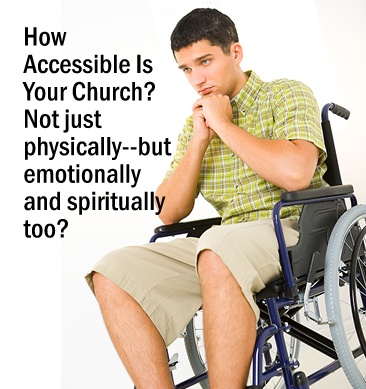How Can Our Church Help The Chronically Ill?
Did you know….
- Nearly 1 in 2 Americans (133 million) has a chronic condition *
- 96% of them live with an illness that is invisible. These people do not use a cane or any assistive device and may look perfectly healthy *
- Sixty percent of the chronically ill are between the ages of 18 and 64 *
- The divorce rate among the chronically ill is over 75 percent *
- Depression is 15-20% higher for the chronically ill than for the average person*
- Various studies have reported that physical illness or uncontrollable physical pain are major factors in up to 70% of suicides*
- About one in four adults suffer from a diagnosable mental disorder in a given year*
- However, the significance of one’s faith has shown to lower one’s risk of depressive symptoms and aid one in better handling a stressful medical event*
- Those who use their religious faith to cope are significantly less depressed, even when taking into account the severity of their physical illness. In fact, the clinical effects of religious coping showed the strongest benefit among those with severe physical disability. Some 87 patients hospitalized with serious illness who also then suffered depression were followed over time in another study. The patients with a deep, internalized faith recovered faster from the depression, even when their physical condition was not improving.*
How Does Your Church Measure Up?
Unfortunately, bible colleges and seminaries often fail by not specifically teaching future pastors how to reach out and minister to the chronically ill. Pastoral support for those with chronic illness may include: counseling, prayer, and specific prayers for healing, however, a few weeks later–when the person has not been healed– pastoral support often disappears. Why? It can be confusing on pastors not knowing what to say and do when God has not granted healing, and often other needs take over.
When members of a church help the one who is suffering with emotional and physical pain, it is a glorious gift. If you have a friend or know someone with a chronic illness, and you attend a church, take a minute to ask that person:
- How can our church help/assist you?
- What do you believe may be lacking in our understanding of your illness/disability?
- How can we help and reach out to you and others with chronic illness/disability?
- Are our events, programs and services truly accessible for those with chronic invisible illnesses?
- How can our church better serve you and others?
Together We Can Make A Difference
September 10-16, 2012 is National Invisible Chronic Illness Awareness Week. This annual event, started in 2002 by Lisa Copen, founder of Rest Ministries**, which is the largest Christian organization that specifically serves the chronically ill, features a variety of ways to get involved including a virtual conference September 10-14 online for free with special guest speakers.
The event is a designated time, worldwide, in which people who live with chronic illness, those who love them and organizations are encouraged to educate the general public, churches, health care professionals and government officials about the effects of living with a disease that is not visually apparent.
2012?s theme is INVISIBLE ILLNESS? SHARE YOUR VISIBLE HOPE!
This is a chance for participants to upload photos that show their hope to encourage others (both ill and healthy).
On the Invisible Illness Week website*** there is a Meme “30 Things You May Not Know About My Invisible Illness”****; you can also sign up to blog for the cause, read guest bloggers’ posts, and get involved in the campaign on Facebook. There is even a free 80-page eBook with 263 tips when you sign up for email!
Through programs and resources, we seek to recognize the daily challenges of more than 100 million adults and children who live with invisible illness. Through acknowledging that despite how “well” they look, they live with the ups and downs of a chronic condition, it is our mission, to encourage and offer compassion.
We seek to educate those who do not live with illness on how to reach out to and encourage those with health difficulties, including what to say and not say and how to meet practical needs.
Hope Giver or Hope Breaker?
Overall, it is our hope that people who live with invisible chronic illness can legally park in a handicapped parking spot without receiving skeptical looks, that friends and family acknowledge that invisible illnesses are real, and for those living with chronic illness/disabilities we hope to share how to not just survive, but truly live–and even celebrate life– despite illness, encouraging others on the same detour in life.
“LORD, you know the hopes of the helpless. Surely you will hear their cries and comfort them.” Psalm 10:17 (NLT)
“The words of the godly are a life-giving fountain; the words of the wicked conceal violent intentions.” Proverbs 10:11 (NLT)
Will you and your church become a “Hope Giver and not a Hope Breaker?”
If you or your church would like more information on how you and/or your church can further assist those living with chronic illness please feel free to contact Michele Williams via email: free2soarhigher@aol.com . Or Lisa Copen @http://invisibleillnessweek.com/contact-us/
Great Resources to Help Churches Minister to the Chronically Ill:
- Beyond Casseroles bookmarks and Rest Ministries brochures
- http://www.joniandfriends.org/church-relations/
- “How to Start a Chronic Illness Small Group Ministry” a book by our founder, Lisa Copen, has some great tips regarding the emotions of it all, as well as the practical tips.
*http://invisibleillnessweek.com/2009/05/06/statistics-chronic-illness/
**http://restministries.com/
*** http://invisibleillnessweek.com
****http://invisibleillnessweek.com/submit-article/30-things-meme/









Such a blessing of a post.
Pingback: Joyful Domesticity » Second: Opening My Eyes to See the Suffering